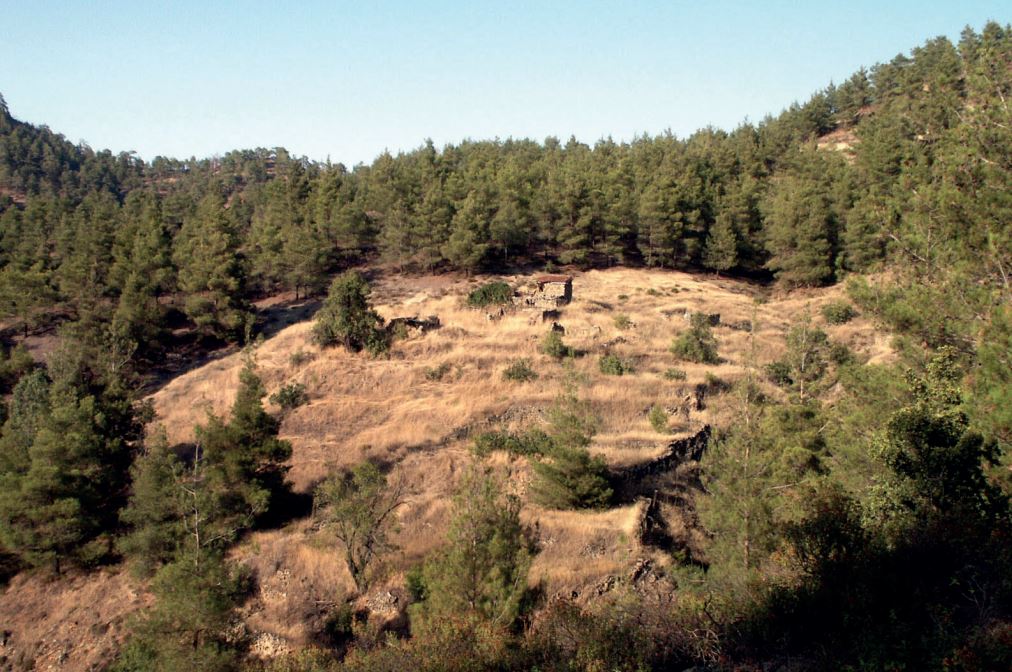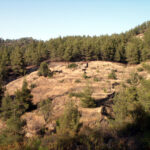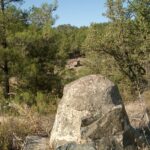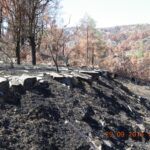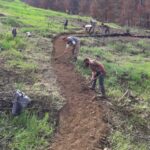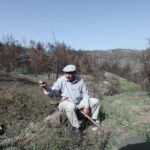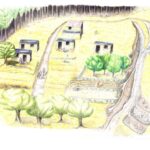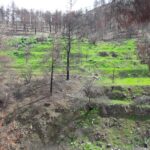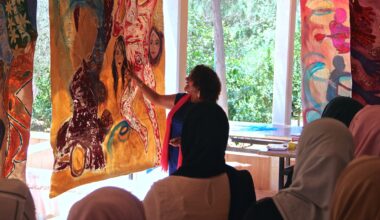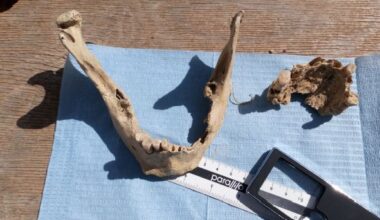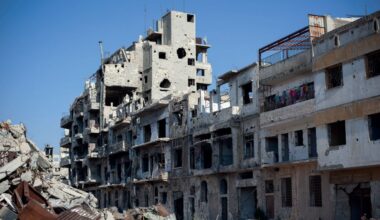Project summary
Taking a new approach to heritage fieldwork, this project aims to address why certain landscapes are important and shifts the focus from that of archaeologists and heritage professionals, to that of local communities. Memory, traditions and story telling are key to this approach as it is through them that communities create and maintain their connections with the past.
Project details
Location: Cyprus
Year(s): 2016
Project director(s):
- Dr Michael Given (University of Glasgow)
- Dr Erin Gibson (University of Stirling)
Lead institutions and funding:
- University of Glasgow
- University of Stirling
- Council for British Research in the Levant (CBRL)
Project feature article (appeared in CBRL’s Bulletin 2018)
In June 2016 we set out from Nicosia to visit the abandoned forest village of Karterouni. We had recorded it back in 2002 as part of the Troodos Archaeological and Environmental Survey Project (TAESP, a project partly funded by CBRL). It was inhabited from about the 17th century to its final abandonment in the mid-20th centuries, and its houses, terraces, threshing floors and water channels are well preserved.
Even in Nicosia, we could smell the smoke in the air, and as we drew closer we could see the huge plume of smoke rising from the mountains behind Karterouni’s still-inhabited neighbour, the village of Ayios Theodhoros. We never made it to Karterouni that day, and that forest fire, one of the worst in recent decades, killed two fire-fighters and burnt 19 sq. km of forest.
We had intended our visit to stimulate our thinking about heritage and what that meant to local communities. As part of TAESP, we had recorded visible archaeology in ways that addressed our research questions and followed a defined methodology. For example, we gave a pair of ruined structures in the valley immediately east of Karterouni a name from the cadastral plan (‘Khalospita’: ‘ruined house’) and a number (TP250), and carefully recorded its masonry, layout, state of preservation and pottery. Our connection to this place – archaeological, academic, aesthetic – made it a place worth recording and later writing about.
When Erin returned to it with Panayiotis Alexandrou Loppas, the son of a shepherd who grew up there, she learnt that to him, it was the goat fold of a man named Alexandros Velleros. Alexandros had a big herd but never stayed at the goat fold, travelling back and forth to his house in the village of Spilia 7km to the south. Panayiotis’ account is a reminder that what is viewed as an archaeological site to one person might be a living, breathing place that is integral to the landscape and identity of someone else.
As we walked along an old mule-path between Ayios Theodhoros and Asinou, in a direction which hopefully took us away from the raging forest fire, we talked about different ways of doing heritage. This was the key component of Erin’s Marie Skłodowska-Curie fellowship on ‘Pathways to Heritage’. Instead of focusing on what archaeologists felt was important about the landscape, both our projects (‘Forest Heritage of Cyprus’, generously funded by CBRL, and ‘Pathways to Heritage’) asked villagers the question: ‘What in this area where you live is important to you?’
Heritage emerges from the connections and relationships that people make with the past in the present. These are often personal connections to places, events and things, though heritage value can also be determined on a national or even international level. Our connections can be multiple and overlapping, and illustrate the significant role that the recent or distant past plays in the richly textured world that we live in.
Colonialism, cairns and clearance
Our survey project had provided rich evidence for past habitation and use of the Adelphi Forest from the Roman to the modern period. Thinking about contemporary connections to the forest, however, it becomes clear that the forest’s resources and the material remains of those who once lived there have been heavily influenced by major changes to the forests in the late 19th century.
When the British took over the administration of Cyprus from the Ottoman Empire in 1878, they set up a Forest Delimitation campaign which drew a line round what was now State Forest and banned or restricted goat grazing and the collection of forest resources such as timber, firewood and resin. Waist-high whitewashed forestry cairns marked the boundaries between cultivated land and forest: they were clearly meant to be seen and to enforce adherence to the new definition of the forest.
Villages like Karterouni became enclaves in the forest, enclosed by forestry cairns and unable to use the resources necessary to live. There was, of course, considerable resistance and ongoing goat grazing. Communities often clubbed together to pay the fines of those, like Panayiotis’ father, who continued to take their goats along old paths between the new cairns. In the Asinou Valley the last of the infamous ‘Asinou goats’ were removed from the forest in 1940 and the inhabitants of Asinou village permanently moved to villages outside of the forest boundary.
In Karterouni, the population was forced to move out in 1947, though many maintained connections with it by tending their fields and orchards. The last resident was Nicholas Savvides, whose house is still visible. When the Forestry Department proposed purchasing this land from remaining landowners in the 1990s, elders like Fadias Pevadikos refused to sell. He tried to fight the proposal in court in 1996 but was unsuccessful.
Heritage work at Karterouni village
Karterouni was completely burnt in the great forest fire of June 2016. The only two storey house, that of Nicholas Savvides, was burned and its roof collapsed. The damage to vegetation prompted an increase in soil erosion, which subsequently influenced the preservation of structures and even the previously well-preserved threshing floors.
In 2017 the Forestry Department decided to create a heritage site at Karterouni that included a reconstructed building, a walking trail and signs telling the history of the village and its significance to those who once lived there. As part of our ‘Forest Heritage of Cyprus’ project, we worked closely with them in doing the work of heritage – collating past archaeological data collected through the TAESP project, documenting contemporary connections to the village, helping to develop new pathways for new interactions, advising on the reconstruction of one of the houses, and writing text for making signs. Our aim was to bring the old village and its people, animals, crops, water supply and soils back to life for modern visitors.
Storypaths at Karterouni
As part of her ‘Pathways to Heritage’ project, Erin developed the idea of ‘Storypaths’ as a technique to document those visual expressions and physical movements that are so important to understanding the meaning of place and the process of heritage formation. She piloted it at Karterouni by using video to document the experience of Panayiotis Loppas (80 years old at the time) as he walked through the village following the forest fire.
In spite of his distress about the fire, Panayiotis made the decision to visit Karterouni because, he said, “it is the village I was born in, I am attracted to it, I feel that it is the place I was born.” The stories he told us as we walked together through the burned village made Karterouni come alive. Standing on one of the lowermost human-made terraces that make up the topography of the village, Panayiotis looked across the valley and told research assistant Andri Evripidou about goat grazing:
Panayiotis: “When they were in here with the herds, they didn’t have any way of communication. With the voices. [Cries out.] The other one, on the top of the mountain up there, was shouting: “Get the lambs home, goats are coming!”. To avoid the lambs suckling the big goats. Pfff, lots of stories.”
Andri: “It was alive.”
Panayiotis: “There’s nothing now.”
There is sadness in his tone – a response to the abandonment of the village and to the forest fire. Still, his stories and those of Andreas Savvides (son of Nicholas) and Fadias Pevadikos keep the memory and place of Karterouni village alive. Their accounts enabled us to create a vivid and intimate understanding of life in the village up to 100 years ago, which in turn has been incorporated into a reconstruction drawing by Lorraine McEwan and our information signs. The Forestry workers who helped to build pathways and clean the threshing floor expressed pride in their work – they had become part of Karterouni’s living history.
We make heritage by creating connections with the past and maintaining them through activities such as telling stories, visiting old ruins and carrying out traditional crafts, cooking and other practices. Karterouni remained an important place to Panayiotis, Andreas and Fadias, regardless of its charred terraces, collapsed roofs and eroding threshing floors. People can still rejuvenate and enliven the past through memory, even when those remains are burned and presumed lost. The ‘Forest Heritage of Cyprus’ project continues to be a collaboration with those who lived and worked in the forest.
From the ashes at Karterouni emerges not only fresh new growth but strong new connections with the land and the past. The deep soils in its old terraces and the long engagement among people and forest create new possibilities, new memories and interactions that will take it forward into a richer future.
For more on a local community’s vision of their own heritage, please see the videos, maps and photos in ‘Telling the Story of Home: Why the Rural Cypriot Village of Nikitari matters’.
Project bibliography
Gibson, Erin and Given, Michael. 2020. Rising from the ashes: Karterouni and the forest heritage of Cyprus. Bulletin of the Council for British Research in the Levant 2018-2019, pp 26-28.
Project gallery
Published:22 November 2021












